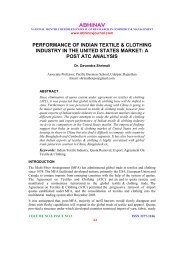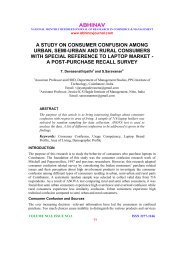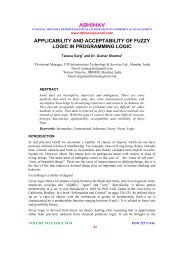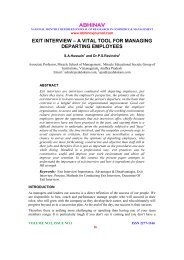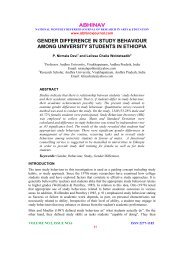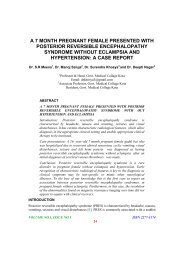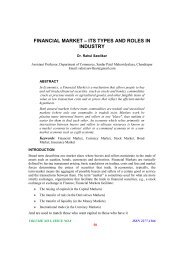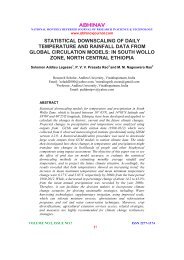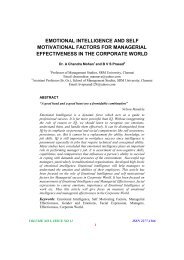The Effectiveness of Waste Stabilization Ponds in The Treatment of ...
The Effectiveness of Waste Stabilization Ponds in The Treatment of ...
The Effectiveness of Waste Stabilization Ponds in The Treatment of ...
Create successful ePaper yourself
Turn your PDF publications into a flip-book with our unique Google optimized e-Paper software.
ABHINAVNATIONAL MONTHLY REFEREED JOURNAL OF RESEARCH IN SCIENCE & TECHNOLOGYwww.abh<strong>in</strong>avjournal.comTHE EFFECTIVENESS OF WASTE STABILIZATIONPONDS IN THE TREATMENT OF BREWERYEFFLUENT THE CASE OF META ABO BREWERYWASTE STABILIZATION PONDS, SEBETA, ETHIOPIADejene Beyene 1 and Dr. P.V.V. Prasada Rao 21 Research Scholar, College <strong>of</strong> Science & Technology, Andhra University,Visakhapatnam, IndiaEmail: dejenebeyeneaau@yahoo.com2 Pr<strong>of</strong>essor, College <strong>of</strong> Science & Technology, Andhra University, Visakhapatnam, IndiaEmail: pedd<strong>in</strong>eniprasadarao@gmail.comABSTRACT<strong>The</strong> objective <strong>of</strong> this paper is to evaluate the efficiency <strong>of</strong> waste stabilizationpond systems owned by Meta Abo Brewery <strong>in</strong> the treatment <strong>of</strong> breweryeffluent. <strong>The</strong> wastewater treatment system consists <strong>of</strong> a prelim<strong>in</strong>arytreatment unit, s<strong>in</strong>gle str<strong>in</strong>g <strong>of</strong> stabilization ponds and a post treatment unit.<strong>The</strong> waste stabilization pond system collects 2476 wastewater each daywith organic load<strong>in</strong>g rate <strong>of</strong> 1241.63 kg/ha.day. <strong>Waste</strong>water samples werecollected at the <strong>in</strong>let and outlet <strong>of</strong> the pond str<strong>in</strong>g and analyzed forbiochemical oxygen demand (BOD), total suspended solids (TSS), totalammonia nitrogen, sulfide, sulfate, nitrate nitrogen, total nitrogen, turbidity,conductivity, chemical oxygen demand (COD), total phosphorus andorthophosphate between September 2011 and June 2012. Non conservableparameters such as dissolve oxygen (DO), temperature and pH weremeasured onsite immediately after sampl<strong>in</strong>g us<strong>in</strong>g handheld portable waterquality measur<strong>in</strong>g <strong>in</strong>strumentation. This was done to determ<strong>in</strong>e theefficiency <strong>of</strong> the waste stabilization pond system so that the f<strong>in</strong>al effluentdischarged from the system to surface water comply with the EthiopianEnvironmental Protection Authority (EEPA) standards. <strong>The</strong> percentageremoval efficiency <strong>of</strong> the pond system was 84.38, 66.10, 59.64, 56.93, 41.83,31.47, 19.68, 15.08, 11.56, 7.90 and 0.80 for total nitrogen, orthophosphate,nitrate nitrogen, sulfide, total ammonia, turbidity, total suspended solids,BOD 5 , total phosphorus, COD and conductivity respectively <strong>in</strong> decreas<strong>in</strong>gorder.<strong>The</strong> results showed that except pH and temperature most <strong>of</strong> the parametersdid not comply with the Ethiopian Environmental Protection Authority(EEPA) standards. COD, BOD 5 , TSS, total nitrogen, total ammonianitrogen, sulfide, turbidity, orthophosphate, specific conductivity and totalphosphorus levels were abnormally high, exceed<strong>in</strong>g EEPA’s red bandsVOLUME NO.2, ISSUE NO.8 ISSN 2277-117410
ABHINAVNATIONAL MONTHLY REFEREED JOURNAL OF RESEARCH IN SCIENCE & TECHNOLOGYwww.abh<strong>in</strong>avjournal.comwash<strong>in</strong>g and clean<strong>in</strong>g <strong>in</strong> place (CIP); which are <strong>of</strong> considerable importance both <strong>in</strong> terms <strong>of</strong>water <strong>in</strong>take and effluent produced (Van der Merwe and Friend, 2002).<strong>The</strong> quantity <strong>of</strong> brewery wastewater will depend on the production and the specific waterusage. Brewery wastewater has high organic matter content, not toxic, does not usuallyconta<strong>in</strong> appreciable quantities <strong>of</strong> heavy metals (possibly orig<strong>in</strong>ate from label <strong>in</strong>ks, labels,herbicides) and is easily biodegradable (Brewers <strong>of</strong> Europe, 2002). <strong>Waste</strong>water frombreweries is divided <strong>in</strong>to three types namely <strong>in</strong>dustrial process wastewater, sanitarywastewater from toilets and kitchens and ra<strong>in</strong> water. Due to high organic content and acidicnature, brewery effluent has the potential to cause considerable ecological damages <strong>in</strong> thereceiv<strong>in</strong>g water bodies (Olajire, 2012).Similarly, effluent to beer ratio is correlated to beer production. It has been shown that theeffluent load is very similar to the water load s<strong>in</strong>ce none <strong>of</strong> this water is used to brew beerand most <strong>of</strong> it ends up as effluent (Perry and De Villiers (2003) as cited <strong>in</strong> Olajire, 2012).Table 1. Dimension <strong>of</strong> waste stabilization ponds, Meta Abo Brewery private companyPond typeAverage surface Depth Volume Retention timearea ( ) (m) ( ) (day)Anaerobic pond 860.52 4.70 4044.44 1.61Facultative pond 860.52 4.7 0 2684.82 1.61Aerobic pond 1183.21 4.7 0 2792.38 2.22<strong>Waste</strong> stabilization ponds are used to treat a variety <strong>of</strong> wastewaters, rang<strong>in</strong>g from domesticwastewater to complex <strong>in</strong>dustrial effluents as well as comb<strong>in</strong>ation <strong>of</strong> both provided that thewastewater is able to be treated biologically and they function under a wide range <strong>of</strong> climaticconditions, from tropical to arctic (Shilton and Harrison, 2003).Several treatment options have been used to treat brewery effluent <strong>in</strong>clud<strong>in</strong>g aerobictreatment. However, brewery effluent is categorized as medium to high strength organicwastewater and needs an <strong>in</strong>tensive amount <strong>of</strong> energy for aeration. <strong>The</strong> other disadvantage <strong>of</strong>aerobic treatment is the large amount <strong>of</strong> waste sludge produced dur<strong>in</strong>g aerobic treatmentwhich will <strong>in</strong>crease the cost <strong>of</strong> operation for the treatment system <strong>in</strong> handl<strong>in</strong>g and disposal <strong>of</strong>the sludge. Thus driven by implementation <strong>of</strong> ISO 14001 certification and more str<strong>in</strong>gentenvironmental legislation the brew<strong>in</strong>g <strong>in</strong>dustry has shown <strong>in</strong>creas<strong>in</strong>g awareness forenvironmental protection and the need <strong>of</strong> susta<strong>in</strong>able production processes to <strong>in</strong>vest <strong>in</strong>biological effluent treatment such as the use <strong>of</strong> waste stabilization ponds (Driessen andVereijken, 2003).However, researches on the treatment <strong>of</strong> brewery wastewater us<strong>in</strong>g oxidation ponds andtheir performance to remove pollutants are limited. <strong>The</strong>refore, the primarily goal <strong>of</strong> thispaper is to critically evaluate the suitability <strong>of</strong> a series <strong>of</strong> an anaerobic, a facultative and amaturation ponds whose bottom l<strong>in</strong>ed by f<strong>in</strong>e sands for the treatment <strong>of</strong> brewery wastewaterby determ<strong>in</strong><strong>in</strong>g the treatment efficiency <strong>of</strong> the system. In addition, draw<strong>in</strong>g from theavailable literature, it suggests better treatment options for the wastewater from the brewery<strong>in</strong>dustry. <strong>The</strong> results obta<strong>in</strong>ed will serve to identify areas where control measures arenecessary, enhance decision mak<strong>in</strong>g tools for management, to identify opportunities forreduc<strong>in</strong>g waste and would be applicable to other breweries operat<strong>in</strong>g <strong>in</strong> the country.VOLUME NO.2, ISSUE NO.8 ISSN 2277-117413
ABHINAVNATIONAL MONTHLY REFEREED JOURNAL OF RESEARCH IN SCIENCE & TECHNOLOGYwww.abh<strong>in</strong>avjournal.comMATERIALS AND METHODSDescription <strong>of</strong> the study area<strong>The</strong> study was conducted from September 2011 to June 2012 <strong>in</strong> Meta Abo Brewery, SebetaEthiopia. Meta Abo Brewery is one <strong>of</strong> the currently exist<strong>in</strong>g eight breweries <strong>in</strong> Ethiopianbrew<strong>in</strong>g <strong>in</strong>dustry. It is located <strong>in</strong> the town <strong>of</strong> Sebeta, 27 kilometers from the capital, AddisAbaba to the South West, <strong>in</strong> the Oromia National Regional State. Geographically, thecompany is located at an average altitude <strong>of</strong> 2182 meters above sea level to the south <strong>of</strong>mount Mogle and at the coord<strong>in</strong>ates <strong>of</strong> 8° 54.68’ North latitude and 38° 55.72’ Eastlongitude. <strong>The</strong> coord<strong>in</strong>ates <strong>of</strong> the study area were fixed us<strong>in</strong>g Global Position<strong>in</strong>g SystemUnit (GPSMAP76, Garm<strong>in</strong> OLATHE®, KS, USA 2009). <strong>The</strong> map <strong>of</strong> the study area wasdeveloped us<strong>in</strong>g ArcGIS 9.1 s<strong>of</strong>tware.Figure 1. Map <strong>of</strong> the study area and location <strong>of</strong> Meta Abo Brewery (Map source: EMA,2012)<strong>The</strong> study area is characterized by biannual ra<strong>in</strong>y seasons: summer ra<strong>in</strong>y season whichoccurs between mid June and mid September is responsible for 70% <strong>of</strong> the annual averagera<strong>in</strong>fall and spr<strong>in</strong>g ra<strong>in</strong>y season which covers the period from February to April. <strong>The</strong>rema<strong>in</strong><strong>in</strong>g months <strong>of</strong> the year are generally characterized by hav<strong>in</strong>g little or no ra<strong>in</strong>fall. <strong>The</strong>maximum and m<strong>in</strong>imum annual temperature varies from 9 0 C to 30 0 C (ENMA, 2012).VOLUME NO.2, ISSUE NO.8 ISSN 2277-117414
ABHINAVNATIONAL MONTHLY REFEREED JOURNAL OF RESEARCH IN SCIENCE & TECHNOLOGYwww.abh<strong>in</strong>avjournal.comMeta Abo brewery was established <strong>in</strong> 1963 by the Ethiopian Government and Ethiopianprivate Nationals with an <strong>in</strong>itial production capacity <strong>of</strong> 50,000 hectoliters per annum and 128permanent employees (ECPC, 2005). It has undergone expansion programs <strong>in</strong> 1970’s,1980’s, 2005 and 2011 with several folds <strong>of</strong> <strong>in</strong>creas<strong>in</strong>g annual production capacity andrais<strong>in</strong>g number <strong>of</strong> permanent employees. <strong>The</strong> company adopted ISO based EMS <strong>in</strong> 2005 forthe first time. Follow<strong>in</strong>g an International bid by the Ethiopian Privatisation and PublicEnterprises Supervis<strong>in</strong>g Agency (EPPESA), the company has sold to Diageo, a UK based<strong>in</strong>ternational liquor firm that operates <strong>in</strong> many countries <strong>of</strong> the world.Figure 2. Partial view <strong>of</strong> Meta Abo Brewery waste stabilization pond system<strong>The</strong> total land hold<strong>in</strong>g <strong>of</strong> the brewery is 369,000 square meter <strong>of</strong> which 25,000 square meteris a built up area. A car park, recreation and horticultural farms occupy the major part <strong>of</strong> thebrewery's premises. Meta Abo Brewery is the only brewery <strong>in</strong>dustry <strong>in</strong> the country whichgets water from a big reserve <strong>of</strong> s<strong>of</strong>t spr<strong>in</strong>g water (locally known as Holy Water <strong>of</strong> St. Abo).<strong>The</strong> spr<strong>in</strong>g water meets the <strong>in</strong>ternational brew standard to be used without any form <strong>of</strong>treatment.Sampl<strong>in</strong>g Methodology, Sample Preservation and AnalysisDur<strong>in</strong>g the study period composite wastewater samples were collected <strong>in</strong> 1L polypropylenebottles <strong>in</strong> five rounds between September 2011and June 20112 at the <strong>in</strong>let (before thewastewater enters the ponds) <strong>of</strong> the pond system. Similarly grab samples were collected atthe outlet (at the po<strong>in</strong>ts where the wastewater leaves the pond system) <strong>of</strong> the pond system.Prior to sampl<strong>in</strong>g the polyethylene bottles were cleaned by <strong>in</strong>cubat<strong>in</strong>g them with 10 % (V/V)nitric acid (analytical, Merck) solution for 48 hours <strong>in</strong> a hot water bath and then washed andr<strong>in</strong>sed with distilled and de-ionized water. <strong>The</strong> polyethylene bottles were thoroughly r<strong>in</strong>sedwith the wastewater from the sampl<strong>in</strong>g po<strong>in</strong>ts before tak<strong>in</strong>g samples. <strong>The</strong> wastewatersamples were brought to Addis Ababa City Adm<strong>in</strong>istration Environmental ProtectionAuthority (AAEPA) water and wastewater laboratory <strong>in</strong> ice kits and analyzed for physico-VOLUME NO.2, ISSUE NO.8 ISSN 2277-117415
ABHINAVNATIONAL MONTHLY REFEREED JOURNAL OF RESEARCH IN SCIENCE & TECHNOLOGYwww.abh<strong>in</strong>avjournal.comchemical parameters accord<strong>in</strong>g to the analytical methods described <strong>in</strong> Standard Methods forthe Exam<strong>in</strong>ation <strong>of</strong> Water and <strong>Waste</strong>water (APHA, 2005) us<strong>in</strong>g graded laboratory reagents.<strong>The</strong> samples were kept <strong>in</strong> a refrigerator at 4 0 C until analyzed for the parameters.Non conservable parameters such dissolved oxygen (DO), pH, electrical conductivity andtemperature were measured onsite immediately after sampl<strong>in</strong>g with the help <strong>of</strong> portablewater quality measur<strong>in</strong>g <strong>in</strong>strumentation (Cyberscan Series 600, EUTECH PCD 650,S<strong>in</strong>gapore) at the <strong>in</strong>let and outlet <strong>of</strong> the pond system.Round averages were calculated for all parameters, from which average performance valueshave been obta<strong>in</strong>ed for the whole study period. <strong>The</strong> study was limited to the end<strong>in</strong>g <strong>of</strong> ra<strong>in</strong>yseason period <strong>in</strong> Ethiopia <strong>in</strong> order to avoid the possible effects <strong>of</strong> ra<strong>in</strong> water on the resultsobta<strong>in</strong>ed.A HACH DR/2010 (HACH Company, Loveland, CO, USA) spectrophotometer was used tomeasure total ammonia-nitrogen, total nitrogen, chemical oxygen demand, sulfide andphosphate accord<strong>in</strong>g to HACH <strong>in</strong>structions. BOD 5 was measured accord<strong>in</strong>g to the methodsdescribed Standard Methods for the Exam<strong>in</strong>ation <strong>of</strong> Water and <strong>Waste</strong>water (APHA, 2005)us<strong>in</strong>g graded laboratory reagents. Gravimetric method was used to determ<strong>in</strong>e the totalsuspended solids (TSS) <strong>of</strong> the wastewater samples at temperature <strong>of</strong> 103 - 105 (APHA,2005). Nitrate-nitrogen was determ<strong>in</strong>ed by Cadmium reduction method us<strong>in</strong>g powder pillowor accuVac® ampoules spectrophotometer. Total Phosphorous (TP) was measured by thepersulfate digestion procedure.Data Analysis<strong>The</strong> data obta<strong>in</strong>ed from the study were analyzed us<strong>in</strong>g descriptive statistics <strong>in</strong> Micros<strong>of</strong>tExcel and SPSS version 16.0 s<strong>of</strong>tware packages. <strong>The</strong> results were expressed <strong>in</strong> terms <strong>of</strong>mean and standard deviation. <strong>The</strong> results were also compared with standard water qualityguidel<strong>in</strong>es. A one-way analysis <strong>of</strong> variance test was used to compare the difference betweenmeans.RESULTS AND DISCUSSIONDeterm<strong>in</strong>ation <strong>of</strong> wastewater flow rate: wastewater is one <strong>of</strong> the most significantwaste products <strong>of</strong> brewery operations. <strong>The</strong> quantity <strong>of</strong> brewery wastewater will depend onthe production and the specific water usage (Olajire, 2012).<strong>The</strong> ma<strong>in</strong> water source <strong>of</strong> the brewery was a big reserve <strong>of</strong> s<strong>of</strong>t spr<strong>in</strong>g water (locally knownas Holy Water <strong>of</strong> St. Abo) which meets the <strong>in</strong>ternational brew standard without any form <strong>of</strong>treatment. <strong>The</strong> current annual production capacity <strong>of</strong> the brewery is 1, 200000 hectoliters.<strong>The</strong> mean wastewater flow rate was carefully estimated by means <strong>of</strong> fill Bucket and StopWatch (fill and empty) method for about 16 days at different time <strong>of</strong> the day. This simplestmethod was chosen due to its simplicity and it also does not require any special equipment.<strong>The</strong> time needed to fill the bucket (plastic bucket <strong>of</strong> 20 ml) was recorded <strong>in</strong> situ andwastewater flow was estimated us<strong>in</strong>g the follow<strong>in</strong>g formula was found to be 2476 .Flow rate ( ) =VOLUME NO.2, ISSUE NO.8 ISSN 2277-117416
ABHINAVNATIONAL MONTHLY REFEREED JOURNAL OF RESEARCH IN SCIENCE & TECHNOLOGYwww.abh<strong>in</strong>avjournal.comEven though substantial technological improvements have been made <strong>in</strong> the past, it has beenestimated that approximately 3 - 10 liters <strong>of</strong> wastewater is generated per liter <strong>of</strong> beerproduced <strong>in</strong> breweries (Kanagachandran and Jayaratne, 2006). Based on this estimation,Meta Abo brewery generates approximately 986.30 – 3287.60 liters <strong>of</strong> wastewater each day.Thus the quantity <strong>of</strong> wastewater discharged by the Meta Abo brewery obta<strong>in</strong>ed by means <strong>of</strong>fill Bucket and Stop Watch method falls with<strong>in</strong> this range.<strong>Treatment</strong> efficiency <strong>of</strong> the pond system: Table 2 shows the results <strong>of</strong> the analysis <strong>of</strong>the various physicochemical parameters. <strong>The</strong> mean DO concentrations (0.22 0.06 mg/L)<strong>of</strong> the treated wastewater <strong>in</strong>dicate that anaerobic condition prevailed <strong>in</strong> the treatment systemwhere oxygen unable to enter <strong>in</strong>to the system through direct diffusion across air-liquid<strong>in</strong>terface or the rate <strong>of</strong> oxygen production through photosynthesis were lower than the rate <strong>of</strong>oxygen consumption through respiration and decomposition <strong>of</strong> organic matter. This might beattributed to a reduced algal activity. This fall <strong>in</strong> DO concentration over the monitor<strong>in</strong>gperiod <strong>in</strong>dicates that the pond is becom<strong>in</strong>g anoxic and some management strategy such asaeration with surface mechanical aerators and mixers, or by various forms <strong>of</strong> diffuserssupplied with compressed air from mechanical blowers or compressors must beimplemented.<strong>The</strong> average pH value <strong>of</strong> the <strong>in</strong>fluent wastewater has shown acidic character. <strong>The</strong> anaerobicbacteria are usually sensitive to pH value less than 6.2. Thus, this acidic wastewater musthave been neutralized prior to its treatment <strong>in</strong> anaerobic ponds. pH values <strong>in</strong>creased slightlyfrom 5.58 <strong>in</strong> the <strong>in</strong>fluent to 6.19 <strong>in</strong> the effluent <strong>of</strong> the treatment plant. This might beattributed to <strong>in</strong>creas<strong>in</strong>g algal activity <strong>in</strong> facultative and aerobic ponds as CO 2 is consumeddur<strong>in</strong>g photosynthesis by algae. <strong>The</strong> <strong>in</strong>crement <strong>in</strong> pH could also be due to high ammoniaconcentrations <strong>in</strong> the effluent.<strong>The</strong> percentage treatment efficiency <strong>of</strong> the pond system was 84.38, 66.10, 59.64, 56.93,41.83, 31.47, 19.68, 15.08, 11.56, 7.90 and 0.80 for total nitrogen, phosphate, nitratenitrogen, sulfide, total ammonia, turbidity, total suspended solids, BOD5, total phosphorus,COD and conductivity respectively <strong>in</strong> decreas<strong>in</strong>g order.<strong>The</strong> mean BOD (431.80 mg/L) and COD (2232.60 mg/L) concentrations <strong>of</strong> the brewerywastewater were similar to values <strong>in</strong>dicated <strong>in</strong> the literature. With this BOD value <strong>of</strong> the<strong>in</strong>fluent wastewater, the calculated organic load<strong>in</strong>g rate on the anaerobic pond was 1241.63kg per hectare per day, which is much lower than the typical organic load<strong>in</strong>g rates <strong>of</strong> 3000kg BOD per hectare per day for the given depth (Hamzeh and Ponce, 2007). <strong>The</strong> effluentBOD and TSS concentrations were higher than that set by the U.S. standards for secondaryeffluent and the European Community Commission for Environmental Protection m<strong>in</strong>imumeffluent standards. This higher value <strong>in</strong>dicated that the pond system was poorly perform<strong>in</strong>gbecause an environmental condition <strong>in</strong> the pond particularly pH, is not suitable for theanaerobic microorganisms to br<strong>in</strong>g about the breakdown <strong>of</strong> organic matter <strong>of</strong> the brewerywastewater.<strong>The</strong> TSS concentration (1809.20 mg/L) <strong>of</strong> the raw wastewater <strong>of</strong> the brewery wastewaterwas much higher than the average TSS concentration <strong>of</strong> domestic wastewater. This might beattributed to the short retention periods and the presence <strong>of</strong> large amount <strong>of</strong> waste gra<strong>in</strong>s thatshould be removed at prelim<strong>in</strong>ary treatment unit.VOLUME NO.2, ISSUE NO.8 ISSN 2277-117417
ABHINAVNATIONAL MONTHLY REFEREED JOURNAL OF RESEARCH IN SCIENCE & TECHNOLOGYwww.abh<strong>in</strong>avjournal.comVarious species <strong>of</strong> nitrogen and phosphorus were analyzed <strong>in</strong> the wastewater stream <strong>in</strong> orderto determ<strong>in</strong>e the nutrient load on the pond and the receiv<strong>in</strong>g water body. <strong>The</strong>re has been a59.64% reduction <strong>of</strong> nitrate nitrogen by the pond system. Abnormally high levels <strong>of</strong> totalnitrogen were found <strong>in</strong> effluent wastewater. This might be attributed to the conversion <strong>of</strong>nitrogen locked up <strong>in</strong> the organic material to <strong>in</strong>organic nitrogen forms. EEPA standardsrequire total nitrogen to be 10mg/L. <strong>The</strong>se high values <strong>of</strong> nitrogen <strong>in</strong> the wastewater implythat the effluent wastewater can cause significant pollution <strong>in</strong> the receiv<strong>in</strong>g water and otherforms <strong>of</strong> environmental damage.Table 2: characteristics <strong>of</strong> physicochemical parameters at the <strong>in</strong>let and outlet <strong>of</strong> thetreatment systemParametersInlet (Influent) Outlet (Effluent) LimitsEfficiency(EEPA,analyzed Mean Mean(%)2003)pH 5.58 0.11 6.19 0.18 6 - 9 -Conductivity≤ 10001255.54 25.71 1245.51 24.98( )μs/cm0.80DO (mg/L) 0.28 0.09 0.22 0.06 - -Temperature ( ) 29.35 1.28 26.93 1.33 20 – 40 -Total NH 3 -N(mg/L)48.20 17.81 28.04 ≤ 20 mg/L 41.83Sulfide (mg/L) 2.64.00 3.54 6.13 2.98 ≤ 1mg/L -132.20Sulfate (mg/L) 344.80 300.00 86.60 ≤ 250 mg/L 12.99COD (mg/L) 2232.60 2056.30 309.44 ≤ 125 mg/L 07.90BOD 5 (mg/L) 431.80 369.67 149.15 ≤ 25 mg/L 15.08Total phosphorus(mg/L)139.64 28.78 123.50 72.07 ≤ 1 mg/L 11.56Total nitrogen(mg/L)68.96 27.38 10.77 ≤ 20 mg/L 84.38Nitrate nitrogen(mg/L)35.83 14.46 5.02 ≤ 10 mg/L 59.64TSS (mg/L) 1809.20 324.631453.00356.83≤ 35 mg/L 19.68Turbidity (NTU)2896.80 1985.00≤ 300 NTU 31.47Ortho phosphate(mg/L)75.72 24.74 25.67 24.66 ≤ 0.5 mg/L 66.10Although the pond system reduced 41.83% <strong>of</strong> <strong>in</strong>fluent ammonia concentration that enteredthe system the effluent concentration was greater than the value recommended by EEPA.<strong>The</strong> concentration <strong>of</strong> total phosphorus was abnormally high <strong>in</strong> effluent <strong>of</strong> the pond system.This is a good <strong>in</strong>dication that the pond system is poorly perform<strong>in</strong>g to remove phosphorusfrom the wastewater. EEPA standards require the effluent wastewater to have a phosphorusVOLUME NO.2, ISSUE NO.8 ISSN 2277-117418
ABHINAVNATIONAL MONTHLY REFEREED JOURNAL OF RESEARCH IN SCIENCE & TECHNOLOGYwww.abh<strong>in</strong>avjournal.comconcentration ≤ 0.5mg/L. This phosphorus content <strong>of</strong> pond effluent compounded with nitrateconcentration can cause eutrophication <strong>in</strong> the receiv<strong>in</strong>g water body.<strong>The</strong> Brewery effluent had a mean temperature 26.93 which was with<strong>in</strong> the limits set byEthiopian Environmental Protection Authority (EEPA, 2003). <strong>The</strong> average electricalconductivity <strong>of</strong> the pond effluent (1245.51mg/L) was above the normal limits set by EEPA.High electrical conductivity <strong>in</strong> the pond effluent may be due to presence <strong>of</strong> ionized species.Many fold <strong>in</strong>crease <strong>in</strong> the concentration <strong>of</strong> sulfide as the wastewater flows from <strong>in</strong>let to theoutlet might be due to the sulfate-reduc<strong>in</strong>g bacteria oxidized the organic compounds andreduce the sulfates to form sulfides.In general, the percentage treatment efficiency <strong>of</strong> the pond for BOD, Sulfide, TotalSuspended solids, COD, nitrate, and total nitrogen were satisfactory. However, the effluentBOD 5 , COD and TSS concentrations were higher than standard set by the U.S. federalstandards for secondary effluents.CONCLUSIONS AND RECOMMENDATIONS<strong>The</strong> brew<strong>in</strong>g process uses large volumes <strong>of</strong> water mostly for the brew<strong>in</strong>g, r<strong>in</strong>s<strong>in</strong>g and cool<strong>in</strong>gpurposes. At same time it also generates large amounts <strong>of</strong> wastewater effluent and solidwastes that must be disposed <strong>of</strong>f or safely treated <strong>in</strong> the least costly and safest way so as tomeet the strict discharge regulations set by EEPA to avoid damages caused to aquatic lifeand the environment. As a result, many brewers are today search<strong>in</strong>g for ways to cut down ontheir water usage dur<strong>in</strong>g the beer brew<strong>in</strong>g process and/or means to cost effectively and safelytreat the brewery wastewater for reuse (Simate et al., 2011).<strong>The</strong> <strong>of</strong>ten various literatures were reviewed <strong>in</strong> order to identify the best treatment methodsfor brewery wastewater and wastewaters hav<strong>in</strong>g similar characteristics. Accord<strong>in</strong>gly, aerobicand anaerobic biological treatment methods have been suggested. However, brewery effluentis categorized as medium to high strength organic wastewater and needs an <strong>in</strong>tensive amount<strong>of</strong> energy for aeration. <strong>The</strong> other disadvantage <strong>of</strong> aerobic treatment is the large amount <strong>of</strong>sludge that has been produced dur<strong>in</strong>g aerobic treatment process which will <strong>in</strong>crease the cost<strong>of</strong> operation for the treatment system <strong>in</strong> handl<strong>in</strong>g and disposal <strong>of</strong> the sludge. In recent years,there has been <strong>in</strong>creas<strong>in</strong>g <strong>in</strong>terest to use <strong>of</strong> waste stabilization ponds to treat the brewerywastewater.Austermann Haun and Seyfried (1994) suggested that waste stabilization pond system isproved to be the ideal treatment method to treat brewery effluent. It is environmentally safer,achieve greater treatment efficiency, more economical and use natural energy sources.However, it has its own disadvantages such as problem related to the local climaticconditions, design and operation. Also the waste stabilization ponds <strong>of</strong> many <strong>in</strong>dustrialwastes with low pH and high organic load have always been problematic as compared toother wastes <strong>of</strong> different orig<strong>in</strong>.Another method highly recommended for the effective treatment <strong>of</strong> brewery effluent is theuse <strong>of</strong> constructed wetlands. It is effective <strong>in</strong> the treatment <strong>of</strong> the wastewater and it is notexpensive for construction, operation and ma<strong>in</strong>tenance. Land will not be a problem too.VOLUME NO.2, ISSUE NO.8 ISSN 2277-117419
ABHINAVNATIONAL MONTHLY REFEREED JOURNAL OF RESEARCH IN SCIENCE & TECHNOLOGYwww.abh<strong>in</strong>avjournal.com<strong>The</strong> authors thank Jimma University for provid<strong>in</strong>g us f<strong>in</strong>ancial aids and analytical<strong>in</strong>struments to carry out this study. We also thank Meta Abo brewery Private Company forallow<strong>in</strong>g us to conduct the study.REFERENCES1. Dejene B. Lemma (2013). Analysis <strong>of</strong> wastewater treatment efficiency and hydraulicperformance <strong>of</strong> waste stabilization ponds, PhD <strong>The</strong>sis. <strong>The</strong> case <strong>of</strong> Meta Abo brewerywaste stabilization ponds, Sebeta, Ethiopia.2. Olajire, A.A. (2012). <strong>The</strong> brew<strong>in</strong>g <strong>in</strong>dustry and environmental challenges, Journal <strong>of</strong>Cleaner Production. Industrial and Environmental Chemistry Unit, Department <strong>of</strong> Pureand Applied Chemistry, Ladoke Ak<strong>in</strong>tola University <strong>of</strong> Technology, Ogbomoso, Oyo,Nigeria. Elsevier Ltd. 1-213. Hunachew B and Getachew R (2011). Assessment <strong>of</strong> <strong>Waste</strong> <strong>Stabilization</strong> <strong>Ponds</strong> for the<strong>Treatment</strong> <strong>of</strong> Hospital <strong>Waste</strong>water: <strong>The</strong> Case <strong>of</strong> Hawassa University Referral Hospital.Department <strong>of</strong> Public and Environmental Health, College <strong>of</strong> Health Sciences, HawassaUniversity, Ethiopia.4. APHA (2005). Standard Methods for the Exam<strong>in</strong>ation <strong>of</strong> water and wastewater, 24th ed.American Public Health Association, Wash<strong>in</strong>gton, D. C.5. EPA (Ethioian Environmental protection Authority) (2003). Guidel<strong>in</strong>e AmbientEnvironment Standards for Ethiopia. Prepared by EPA and UNIDO under ESDI projectUS/ETH/99/068/, Addis Ababa, Ethiopia.6. Micros<strong>of</strong>t ® Office Excel (1985-2007). Micros<strong>of</strong>t Excel Inc., 2007, USA.7. HACH (1996-1999). Spectrophotometer Handbook DR/2010 Procedures Manual, USA.8. National Metrological Agency (2012) Report on weather condition <strong>of</strong> Ethiopia.9. Mara DD. (2004). Domestic <strong>Waste</strong>water <strong>Treatment</strong> <strong>in</strong> Develop<strong>in</strong>g Countries. EarthscanPublications, London.10. Mara, D. and Pearson, H. (1998). Design Manual for <strong>Waste</strong> <strong>Stabilization</strong> <strong>Ponds</strong> <strong>in</strong>Mediterranean Countries. Lagoon Technology International; Leeds, England.11. Driessen, W. & Vereijken, T. (2003). Recent developments <strong>in</strong> biological treatment <strong>of</strong>brewery effluent. Paper presented to the Institute and Guide <strong>of</strong> Brew<strong>in</strong>g Convention,Liv<strong>in</strong>gstone, Zambia. Retrieved June 10, 2013, Available:http://www.environmentalexpert.com.12. Mara, D D (1997). Design Manual for <strong>Waste</strong> <strong>Stabilization</strong> <strong>Ponds</strong> <strong>in</strong> India, LagoonTechnology International, Leeds.13. Simate, G.S., Cluett, J., Iyuke, S.E., Musapatika, E.T., Ndlovu, S., Walubita, L.F.,Alvarez, A.E., 2011. <strong>The</strong> treatment <strong>of</strong> brewery wastewater for reuse: state <strong>of</strong> the art.Desal<strong>in</strong>ation 273, 235e247.14. Kanagachandran, K., Jayaratne, R., 2006. Utilization potential <strong>of</strong> brewery waste watersludge as an organic fertilizer. J. Inst. Brew. 112 (2).VOLUME NO.2, ISSUE NO.8 ISSN 2277-117420
ABHINAVNATIONAL MONTHLY REFEREED JOURNAL OF RESEARCH IN SCIENCE & TECHNOLOGYwww.abh<strong>in</strong>avjournal.com15. Wa<strong>in</strong>wright, T., 1998. Basic Brew<strong>in</strong>g Science. Magicpr<strong>in</strong>t (Pty) Ltd., SouthAfrica.Walter, S., Glas, K., Parlar, H., 2005. Wassermanagement <strong>in</strong> derGetranke<strong>in</strong>dustrie. Brauwelt 33, 972e976.16. Van der Merwe, A.I., Friend, J.F.C., 2002. Water management at a malted barleybrewery. Water SA 28 (3), 313e318.17. Brewers <strong>of</strong> Europe, October 2002. Guidance Note for Establish<strong>in</strong>g BAT <strong>in</strong> the Brew<strong>in</strong>gIndustry. Brewers <strong>of</strong> Europe, Brussels.18. Glonya, E.F. and Esp<strong>in</strong>o, E. (1969). Sulfide production <strong>in</strong> waste stabilizationponds. Journal <strong>of</strong> the Sanitary Eng<strong>in</strong>eer<strong>in</strong>g Division, American Society <strong>of</strong> CivilEng<strong>in</strong>eers, 95(SA3), pp.607-628.19. Gloyna, E.F. (1971). <strong>Waste</strong> <strong>Stabilization</strong> <strong>Ponds</strong>, Monograph Series No. 60, WorldHealth Organization, Geneva, Switzerland.20. Hamzeh, R. and Ponce V. M. (2007). Design and Performance <strong>of</strong> <strong>Waste</strong> <strong>Stabilization</strong><strong>Ponds</strong>. http://www.ponce.sdsu.edu.21. Taleb Safiedd<strong>in</strong>e (2007). Hydrodynamics <strong>of</strong> waste stabilization ponds and aeratedlagoons. PhD <strong>The</strong>sis, Department <strong>of</strong> Bioresource Eng<strong>in</strong>eer<strong>in</strong>g, Macdonald Campus,McGill University, Montreal, Canada.22. C.P. Leslieg RadyJ, R., Glen T. Daigger and Henryc .Lim (1999). Biologicalwastewater treatment, second edition. Marcel Dekker, Inc. 270 Madison Avenue, NewYork, NY 1001 6.23. ECPC (2005). Ethiopian Experience on EMS Implementation towards ISO14001Certification. Addis Ababa, ECPC.24. Tesfalem Fikresilasie and Hammed Sulaiman (2011). Impact <strong>of</strong> brewery effluent onriver water quality: <strong>The</strong> case <strong>of</strong> Meta Abo brewery factory and F<strong>in</strong>chewa river, Sebeta,Ethiopia. School <strong>of</strong> Graduate Studies <strong>of</strong> the Addis Ababa University, Master <strong>The</strong>sis.VOLUME NO.2, ISSUE NO.8 ISSN 2277-117421





